Silver Lab – The Facts About Silver Labrador Retrievers
Nothing starts a lively conversation among Labrador fans quite so quickly as the topic of silver Labs! Silver Labradors are basically chocolate Labs with a twist. They have a gene that dilutes that rich chocolate fur and turns it into a pale, silvery grey color.

Where that gene came from, how it got into Labs and whether it should be there at all, is a debate that has been raging for decades. So I’m going to dig into the evidence and find out what’s going on with this controversial Lab!
- What are silver Labs really like?
- Introducing the dilute gene
- The great silver Lab controversy!
- Pros, cons, and buying tips
Whether you think the Silver Lab is a disaster or a delight, you should find plenty here to interest you and you’re welcome to add your thoughts to the many comments below. Let’s start with the facts and then move on to the debate.

Introducing The Dilute Gene
There are only three different colors of Labrador Retriever recognized by the American Kennel Club. Those colors are:
Missing from the list you’ll notice are cream, white, fox-red, champagne, charcoal and silver. The first three are simply variations in the coat color of the yellow Labrador, and are registered with the AKC as yellow Labs.

The last three, are a bit different. They are dilutions of the three major colors. Champagne is a dilution of yellow. Charcoal is a dilution of black, and of course silver is a dilution of chocolate.
The coat color dilution gene is common in many animals including dogs, cats and rabbits. And the AKC recognizes several dog breeds in diluted colors. The Weimaraner is one example. And the Chesapeake Bay Retriever is another.

Labradors are not included among those breeds where the dilution gene is accepted. However the AKC will allow silver Labs to be registered, provided they are registered as chocolate.
This is a source of major annoyance to many Labrador enthusiasts. Many of whom think that silver labs should not ever be registered as pedigree dogs. And who believe that admitting these dogs to the breed register has allowed the spread and proliferation of silver Labs to take place across the USA
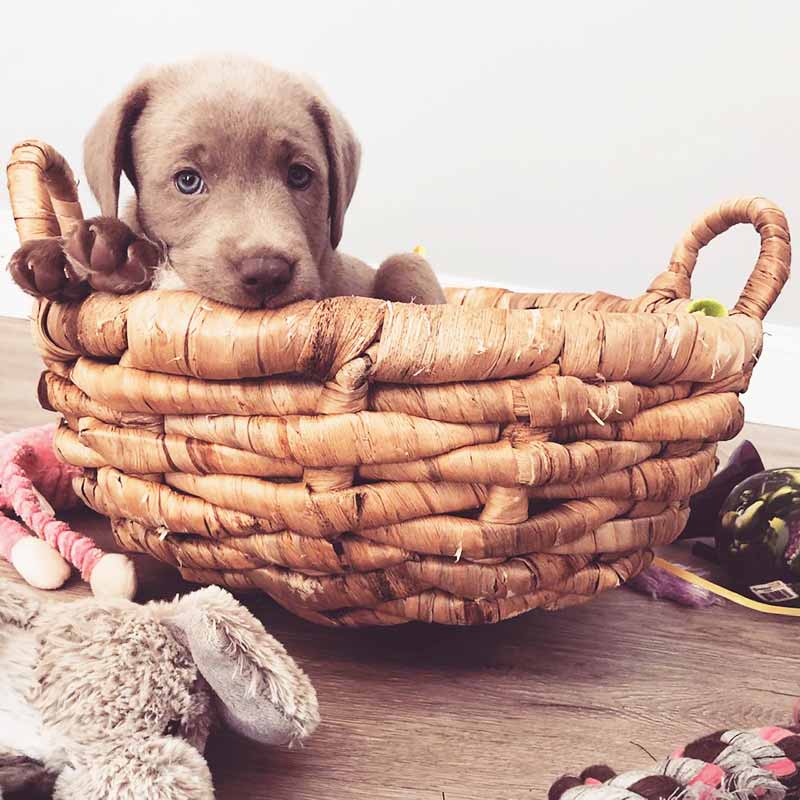
There are many opinions on the rights and wrongs of breeding and registering Silver Labs, and we’ll be taking a closer look at them, but those are the bare facts as they stand at the moment. First let’s dig into the genetics, and find out how we get silver fur on a chocolate Lab.
How The Dilute Gene Works
You can read about the way B and E genes control the underlying coat color of the three recognized Labs in this article on Labrador color inheritance.
The gene that dilutes chocolate fur to silver is known as the D gene. And like many genes, the D gene acts as a type of switch. Every dog with dilution genes inherits a pair of them. One from each parent. And there are two types of D gene. Big D and little d

So there are three possible combinations that your Labrador can inherit
- DD
- Dd
- dd
Only a chocolate dog with two little ds can be silver. That’s because the big D gene is dominant. It over-rides, or switches off, the little d gene whenever they are paired together. So if your dog inherits just one little d gene, the color dilution will not take place and your dog will have a normal full strength chocolate coat. They will however, pass on that little d gene to around half of any puppies they may have.
In some breeds of dog, all individuals have two little d genes. Weimaraners are one example. And for many decades there were no recorded instances of the dilute coat in Labrador Retrievers.

Which raises a number of questions, including:
- When did the dilute gene first appear in Labradors?
- How did the dilute gene get into the Labrador breed?
- Should silver Labs be registered as pedigree dogs?
We’re going to go into those in some detail in a moment. But first let’s look at what you and your family are getting into, if you decide to buy a silver Lab puppy.
What Are Silver Labradors Really Like?
Silver Labs make great family pets. They need plenty of exercise and are ideally suited to active, outdoor life.
All Labradors can be very bouncy and excitable when young so a silver Lab puppy isn’t always a great match for toddlers or those unsteady on their feet. But an older, calmer, rescue Lab can make a perfect companion for younger children.
Labradors are generally very friendly and sociable dogs that love company. So your silver Lab is likely to be happier in a family where there are people at home for part or most of the day.
Like all Labs they shed, heavily at times, so if perfect carpets and soft furnishings are your dream, then they might not be the best pet for you.
How big do silver Labs get?
Because they are essentially a variation on the chocolate Lab, you can expect the same size range in your dog once they are fully grown. The breed standard height for a Labrador is up to 24 and a half inches for a male, and an inch shorter for a female. Individuals can vary a couple of inches or more either side of that.
When it comes to body weight, the variations can be even greater and will depend on which of two groups (American or English) a silver Lab falls into. Male Labs often reach about 70lbs in weight. Females about 10lb lighter. But there can be as much as 20lbs difference either side of that average.
American Labs bred for hunting and retrieving are slimmer, taller and often lighter than the chunkier English type that you see in the show ring
Are silver Labs rare?
As a relatively new color variation, silver Labs are rare in some countries. Partly because registration of silver puppies is not widely permitted.
Some national kennel clubs and breed clubs have clarified their views on silver Labradors by issuing statements about them. You can find some of these statements in the links below:
Even in the USA, silver is still a more unusual color and silver puppies can be harder to find than black, yellow or brown. That can have an impact on the price of your puppy.
How much do silver Labs cost?
Prices vary greatly but as a rough guide you can expect to pay upwards of $1000 for a silver Labrador puppy. When you are considering whether or not you can afford a silver puppy remember that medical insurance will likely be your greatest outlay over the dog’s lifetime. Not the once only purchase price.
You may have heard that silver Labs are over-priced. In fact objections to so-called overpricing are common in dog breeding and not confined to the silver Lab. The same accusations are often aimed at Labradoodle breeders and Cockapoo breeders.
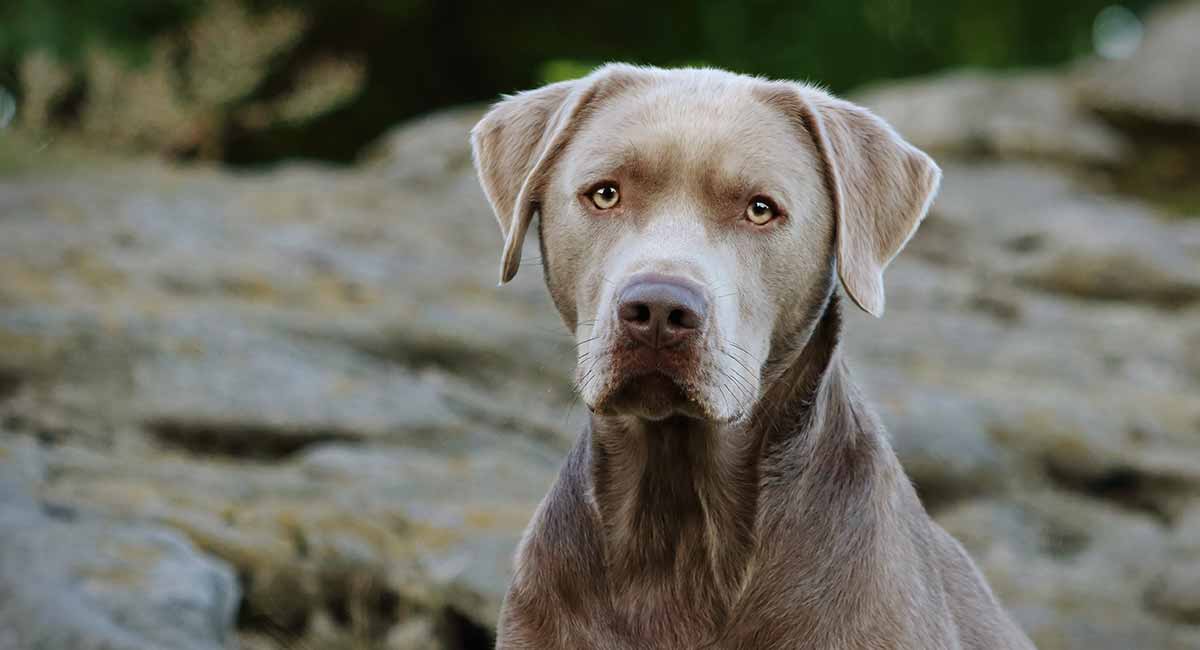
Many purebred dog breeders feel it is outrageous to charge large sums of money for dogs that are crossbred. And some view the silver Labrador Retriever as a cross breed.
Are silver Labs healthy?
Silver Labs suffer from the same health issues as other purebred Labs. Including a predisposition to joint problems and to over-eating!
Two studies record Labrador lifespan at between 11 and 12 years of age and Labs also have a higher rate of cancer (at 31% of all deaths) than some other breed
On balance, Labs are a fairly healthy and well constructed breed, free from the disabilities that plague some other purebred dogs. But there is a potential health issue associated with the coat color dilution gene which you need to be aware of.
Color dilution alopecia
The color dilution gene, that dd which gives us the pale silvery coat, is sometimes associated with coat problems. Specifically, it may be linked to a kind of hair loss.
The problem is known as “color dilution alopecia” and is more common in dogs that have the color dilution gene, dogs like Weimaraners, and now, silver Labradors.
It isn’t usually a life threatening condition, but it also isn’t curable. It can lead to progressive hair loss in young dogs and potentially recurrent infection in the hair follicles.
Thankfully, coat dilution does not always lead to skin problems. Not all dogs with the dd gene carry the faulty alopecia version and most silvers are, in fact, free from alopecia. In most respects therefore, silver Lab health is much the same as that of any purebred Labrador.
Ok, so we’ve covered what you can expect from a silver lab, and how they are both different from, and the same as, other Labs. Now it’s time to address the debate!
The Great Silver Labrador Controversy
Each time we discuss this topic on the Labrador Site’s Facebook page there is some anger expressed by those that are opposed to the very existence of silver Labradors. Though I do think that this is getting less over time, and that these dogs are becoming more widely accepted.
Reports of silver Labradors seem to have first appeared in the United States in the 1950s. Culo Silver Labs was one of the early kennels to produce this new silver color. You may be interested to read this report of an interview with the owner Dean Crist giving his account of the history of the silver Lab.
Much of the debate is focused on how the dilute gene that causes silver fur, got into our Labs in the first place. There are actually only a few options that can explain the appearance of a new gene in a purebred dog. We’ll look at each of these in turn
- mixed breeding
- spontaneous mutation
- hidden genes
The first explanation is that at some point, an outcross occurred, between a Labrador and a breed of dog that carries the dilute gene. A Weimaraner for example.
#1 Mixed breeding
The argument that silver Labs are not purebred, is quite a popular one. Many people believe that the first silver Labs were crossbreeds.
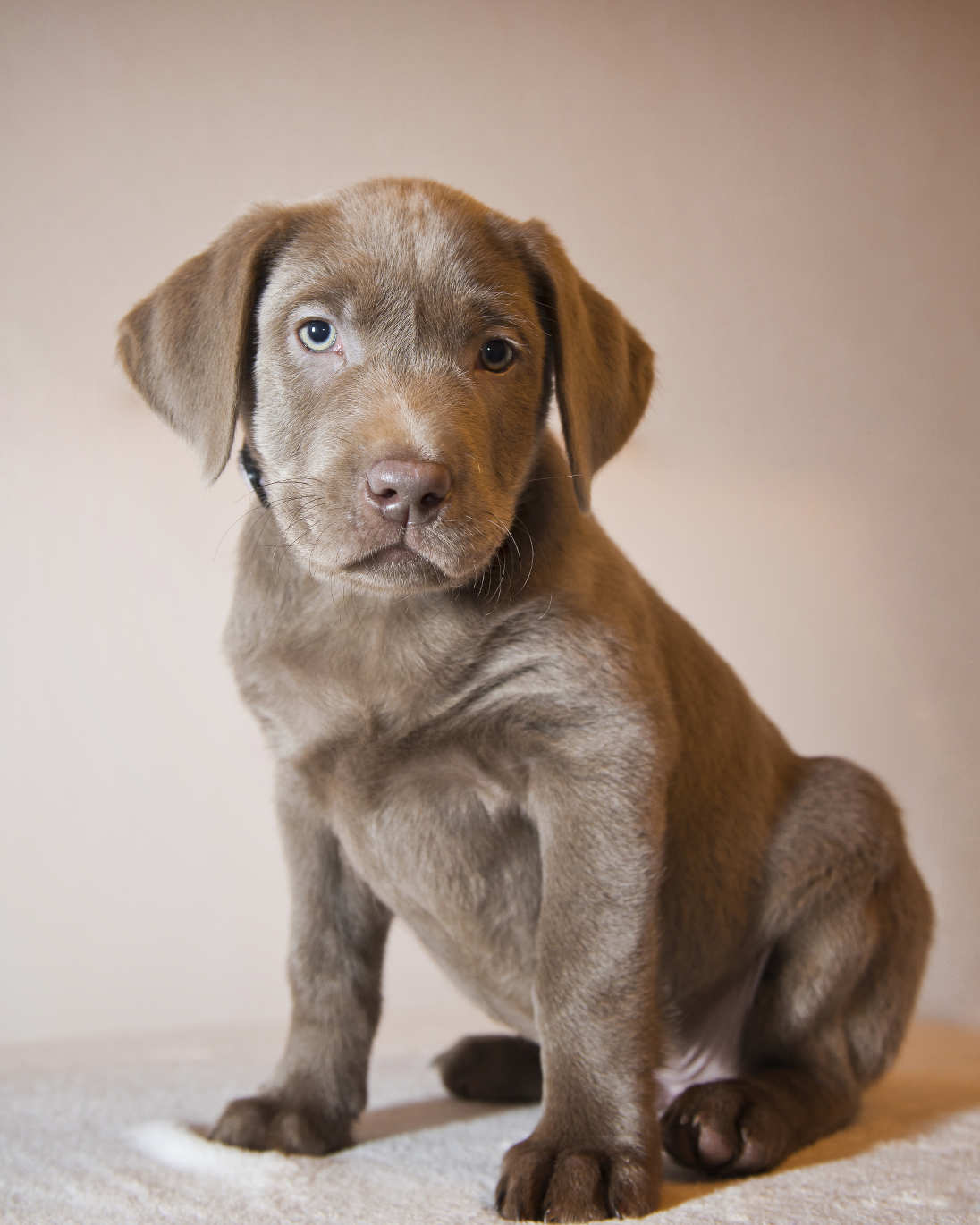
The theory sounds plausible enough as there are clear motives for dog breeders to create a new color variation in an existing breed.
Motives could include financial gain (though breeders couldn’t have known initially how popular the color would be), attention, or just the sheer fun of creating something new.
Diane Welle of Blue Knight Labs does not go quite so far as to directly accuse the breeders concerned
She wrote:
“There have been accusations that these “rare” silver Labradors are actually a cross between a Labrador and a Weimaraner. I will let you be the judge, as there is no evidence at this time, one way or the other. However, it is interesting to note that Silver Labradors can be traced back to two breeders. Those breeders are Dean Crist (Culo) and Beaver Creek Labradors.
Both of their lines trace back to Kellogg kennels (LE Kellogg and Harold E Kellogg) Kellogg Kennels began breeding Labradors in 1922. Guess what else they’re famous for breeding? They’re credited for the ‘rare’ pointing Labrador of course!”
Her point is that ‘pointing’ is, of course, an HPR (hunt point retriever) trait, and Weimaraners are HPRs. An update to her original article, however, also notes that she previously claimed that Weimaraners were also bred in those same kennels, but found out that that fact was in doubt.
Those in favor of the Weimaraner outcross theory often claim silvers have a houndy look about them. To be fair, this is true of many field-bred Labradors of any color. And most silver Labradors today look pretty much the same as any other Labrador Retriever – apart from the fact that they are silver.
The cross-breeding theory has recently lost some credibility due to genetic testing of silver Labs, which has so far failed to show a link to Weimaraners.
#2 Spontaneous mutation
It is not uncommon for genes to mutate. And a spontaneous genetic mutation is another way that a rare or unusual characteristic can appear in a family of dogs that were previously unaffected by it.
This isn’t a popular theory for the appearance of the dilute gene in the silver Labrador. Partly because the other two explanations are both so plausible.
And for a mutation to be identical to a gene that already exists for an unusual coat color in another breed would be something of a coincidence. Many people feel that the spontaneous appearance of this dd dilution gene in the Labrador Retriever gene pool is, to say the least, unlikely. However, it cannot be entirely ruled out.
# Hidden genes
Some people argue that the rare dilute gene has been present in Labradors all along, and that it only appeared, as rare diseases sometimes do, when two closely related dogs were bred.
The capacity of “rare” genes to remain hidden for long periods of time is a phenomenon that most scientists are aware of. This explanation for the appearance of the silver Labrador in the 1950s is perhaps the most valid alternative to the mix breed theory.
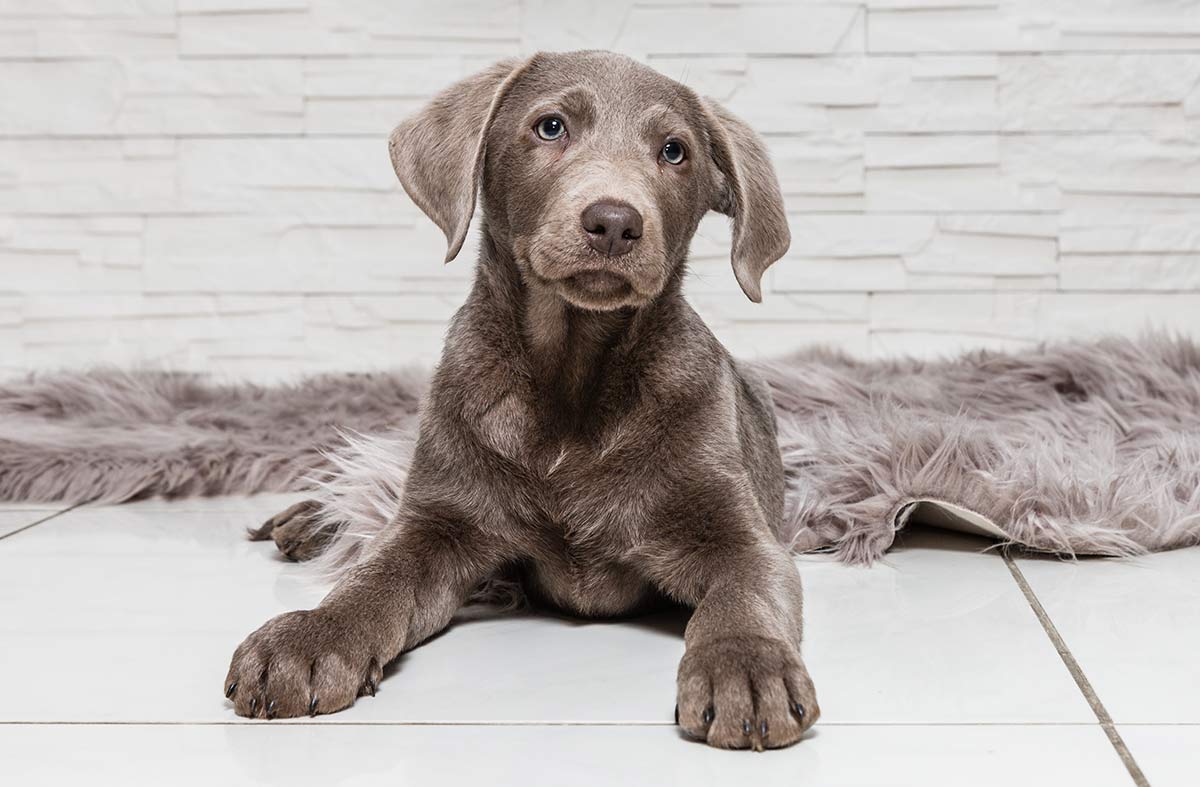
Genes carrying rare diseases or indeed any rare attribute, can remain hidden for decades, only to appear when closely related dogs are mated together. This happens more frequently when gene pools are small, as they are in our pedigree dog populations.
A good example of how that works is B color gene in Labrador. This gene determines whether or not a Lab is basically black or brown. Brown is recessive, just like the color dilution gene, and a Lab needs two copies of the little b brown gene to have a brown coat. And brown labradors only became common when breeders deliberately set about mating them to one another.
The first Labradors were not registered by the AKC until 1917. Before then there would have been regular outcrossing with other similar breeds. Including the Chesapeake Bay Retriever, a breed that does have the dilute gene.

So it is entirely plausible that the little d gene passed from Chesapeakes into one or two Labs before the Labrador pedigree registers were closed and remained hidden in the breed only to reappear in the 1950s when the demand for Chocolates was beginning to rise.
Does It Matter?
Some of you will be bemused at all this fuss over a color. And wonder why it really matters how the silver color got into the Labrador breed. And to some extent I share that view.
I breed rabbits, and with purebred rabbits it’s very common for new colors to be recognized from time to time within established breeds. There are protocols controlled by the American Rabbit Breeders Association as to how this happens, but it’s generally seen as a beneficial and interesting event, not something to be afraid of.
Why it should be considered so radical to do the same in a breed of dogs, I’m not entirely sure!
Of course, most Labrador breeders care very deeply about the future of their breed. Some are concerned about the impact of accepting a genetic change in their beloved breed, without what they feel to be proper consideration.
They are angry at what they see as a dishonest Trojan horse operation to sneak what may be an outcross into the breed line. Pedigree breeders are also commonly committed to the concept of closed registry breeding. And are alarmed at what they consider a threat to the purity of the breed.
Concerns about inbreeding
Some breeders are also concerned about inbreeding in silver Labs. Inbreeding is always a potential problem when breeding animals within a closed gene pool such as our pedigree dog registers. But the problem is made worse when focusing on a small part of that gene pool such as a particular color.
It may be that inbreeding in silver Labradors will not be the problem that it once appeared to be. Former Labrador breeder Jack Vanderwyk, a vehement opposer of silver Labradors, conceded in 2012 that:
Today, in 2012, many, many generations later, the ‘silver’ Labrador population has a fairly viable gene pool, with seven distinct, (almost) unrelated lines. As a result, the average COIs (Coefficient Of Inbreeding) are often not higher than those of other Labrador lines. This means that we shouldn’t underestimate the ‘silver’ population.
It is worth remembering that any risk of inbreeding can be reduced by ensuring a low co-efficient of breeding between the parents of each litter. A knowledgeable breeder will be able to help you with this.
Puppy mills and backyard breeders
There have been concerns that many silver Labrador puppies are irresponsibly bred by backyard breeders or in puppy mills. These concerns can of course apply to any popular breed but are more of a worry when a particular cross breed or color variation become so popular the prices are driven up and less scrupulous breeders try to cash in.
But as silver Labs become more mainstream, there are clear signs that responsible breeding practices are being adopted. And it is certainly possible now, to buy a silver Lab from a reputable breeder
Pros, Cons, And Buying Tips
One of the downsides to bringing a silver Lab into your life is that you may experience unpleasant reactions from those that think silver Labs are ‘ruining the breed’. Or who believe that they should be banned. The comments and social media posts can sometimes be very hurtful
Cons
- Some people may be rude about your dog
- You won’t be able to compete your dog in the show ring
- You may have to pay a higher price than you would for a regular color Lab
- It might be harder to find a responsible breeder in your area
- There may be a small risk that your dog will get alopecia
Pros
- Your silver Lab is likely to have the health and fitness of any other Lab
- This Lab will be as lovable and trainable as any other Lab
- Your Lab will probably be a great family pet
- You will have the pleasure of owning an unusual and beautiful dog
There are questions regarding the registration of silver Labs born in the future. You should be aware that there are people campaigning to have silver Labs de-registered.
Should they succeed it could affect those who want to breed from their dog, or who want to compete with their dog in obedience or field trial competitions that are only open to registered pedigree dogs.
Tips For Buying A Silver Labrador puppy
If you decide to bring a silver Lab puppy into your life, it is very important to find a responsible Labrador breeder.
You’ll need a breeder who health tests all their dogs before breeding, and whose dogs are a part of their lives, not just breeding machines.
Happily, breeding silver Labrador puppies is not mutually incompatible with being a responsible breeder. But you will need to be diligent in order to avoid puppy mills and bad breeding practices.
Silver Labrador puppies should only be purchased from breeders that have tested the puppy’s parents for hip and elbow dysplasia, PRA (inherited blindness) and CNM (a muscle wasting disease.
Remember that a silver Labrador, if registered with a kennel club, will be registered as chocolate. Check the pedigree and health certificates very carefully.
You can find out more about how to find a good Labrador breeder in this article.
Your Silver Lab
If you share your life with a silver Lab, we’d love to hear about them, and about your experiences in finding him or her. We’d also be interested to know if you have experienced any prejudice against your dog because of his unusual coat color.
We love to hear from our readers. So whether you adore silver Labs or oppose them, your politely expressed views are very welcome! Just drop them into the comments box below.
Let us know what you think and why!
References And Further Reading
- “Purebred Vs. Mutt,” The Labrador Site, 2019
- “Dilute Coat Color D-Locus and New D2-Locus,” Animal Genetics, 2019
- “Dilution D Series,” Dog Genetics
- Welle, M, et al., “MLPH Genotype – Melanin Phenotype Correlation in Dilute Dogs,” Oxford Academic Journal of Heredity, 2009
- “Q And A With Dean Crist,” Silver Labs – Just The Facts
- Welle, D, “No Such Thing – Silver Labradors,” Blue Knight Labrador Retrievers, 1990
- “Breed Color Position Statement,” National Labrador Retriever Breed Council of Australia, 2010
- “Silver Labs,” The Labrador Club of New Zealand
- “What’s In The Gene Pool?” Institute of Canine Biology, 2017
- “How Population Size Affects Inbreeding,” Institute of Canine Biology, 2017
- Wagner, S, “The Truth Behind ‘Silver’ Labradors,” Woodhaven Labrador Retrievers
- Hered, J, “A noncoding melanophilin gene (MLPH) SNP at the splice donor of exon 1 represents a candidate causal mutation for coat color dilution in dogs,” 2007
- “Color Dilution Alopecia,” Animal Dermatology Clinic, 2010
- Philipp, U, et al., “Chromosomal assignment of the canine melanophilin gene (MLPH): a candidate gene for coat color dilution in Pinschers,” 2005
- Philipp, U, et al., “Polymorphisms within the canine MLPH gene are associated with dilute coat color in dogs,” 2005
- “Silver Labs – Improvement Movement,” Silver Labs Blog
- Zeirath et al Frequency of five disease-causing genetic mutations in a large mixed-breed dog population. Plos one (2011–2012)

Free Labrador Updates!
Get my training tips, news, reviews, and the latest from The Labrador Site delivered to your inbox

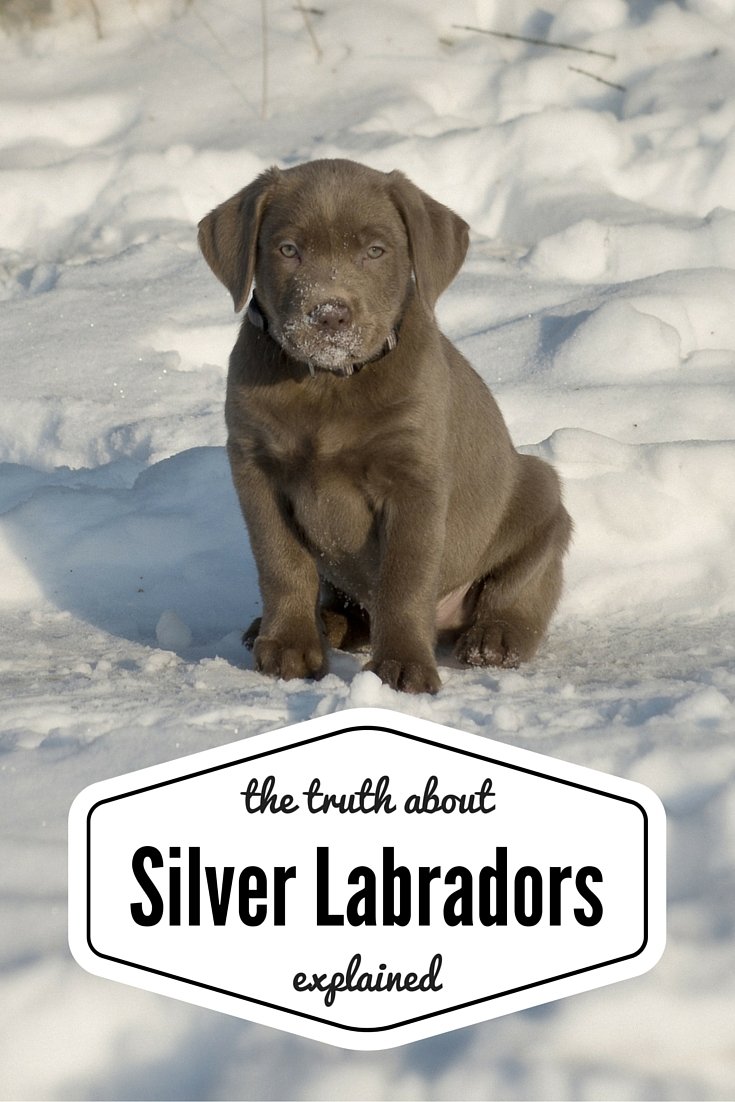
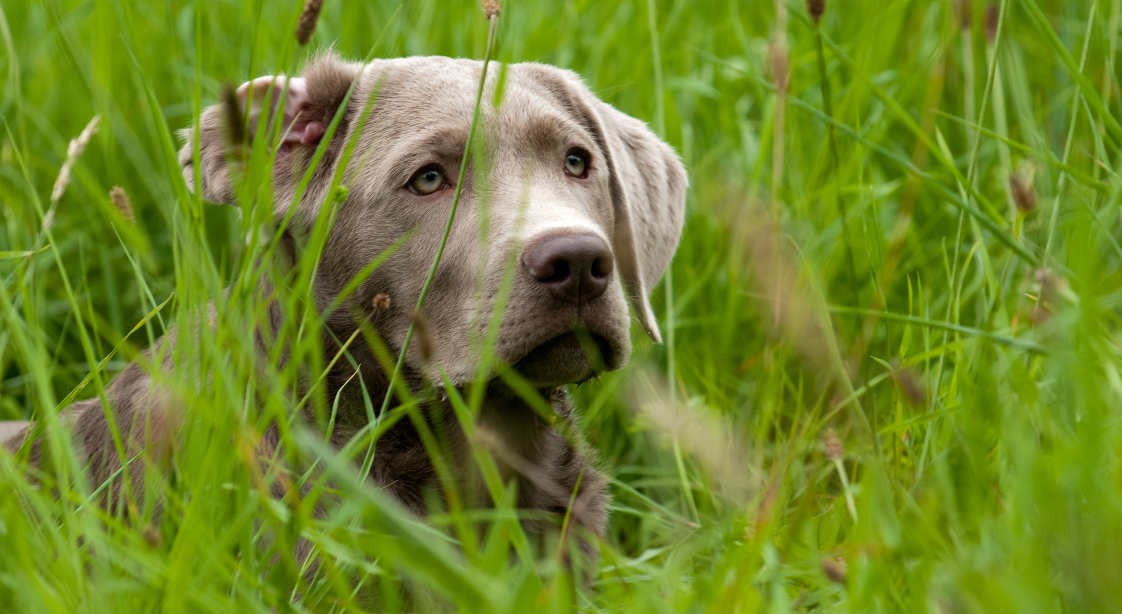
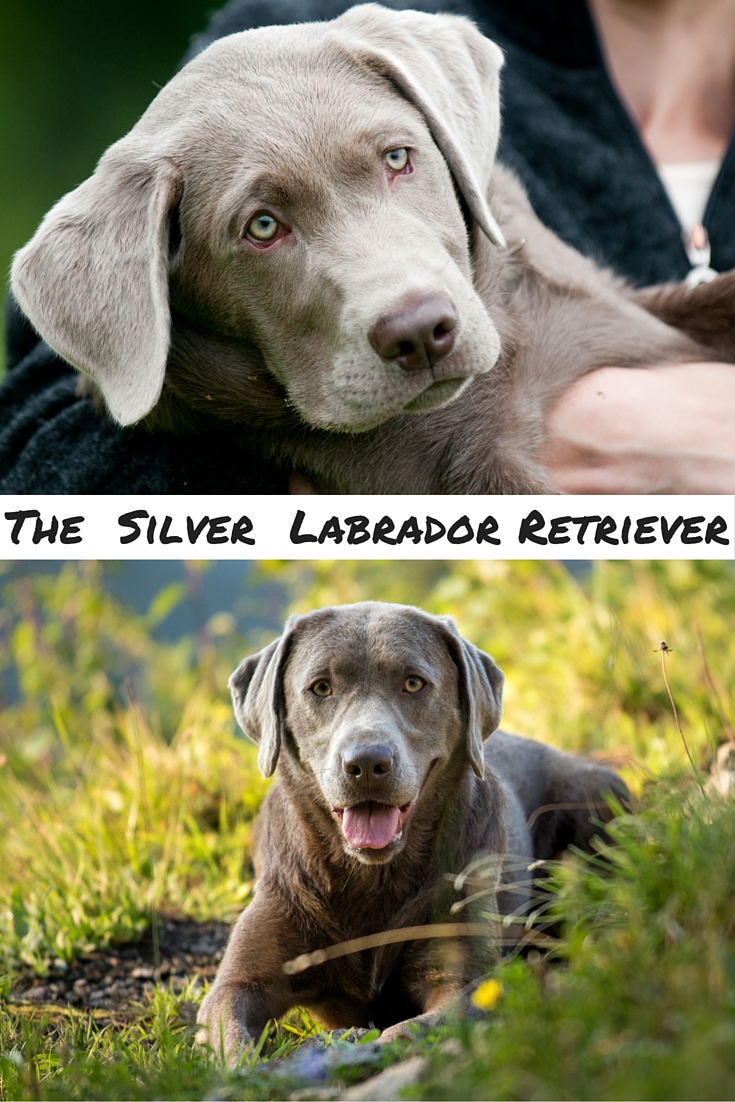


Great article. Only thing I saw wrong was most dilutes are not silver (chocolate). There are many that are also charcoal (black) and champagne (yellow). As for those saying it is still dishonest to register silvers as chocolate that is just foolish. They are chocolate labs! People register them as such because that is what they are! Chocolate labs are “bb”, if they contain even one dominant “B” they would be black (or if they are “ee” yellow regardless of what alleles they have the B locus).
Silvers are “bb”. What?! Yes silvers are chocolate. Basic fact. Same reason we register fox red as yellow, because they are yellow. Fox red and silvers are just descriptor words to more aptly descibe the color of a dog. It’s not the actual base coat color. We register the base coat color, and there is no dishonesty in registering a dilute as their base coat.
It’s not dishonest to register a silver as chocolate. They are chocolate labs. If bred to another chocolate they will have all chocolate pups, if bred to a black who doesn’t carry chocolate they will have all black pups. Same exact thing a chocolate lab. Why? Because they are chocolates! Silver is a descriptor word, like saying you own a fox red lab. No you own a yellow lab and register it as such. Is that dishonest? No! Because a fox red lab is yellow (ee)and a silver lab is chocolate (bb). It’s as easy as that.
My first lab I got from a home breeder was supposedly a purebred lab. I didn’t get her because I wanted to show her, she was purely meant to be a wonderful pet. I met the mother, who was purebred and registered, but not the father. The person I got my beautiful chocolate baby from told me then that she “couldn’t find the paperwork” on the father and therefore discounted her price. I wasn’t concerned as I had no intentions of registering, breeding or showing her. I got her to be the beautiful chocolate girl she obviously was. She recently passed due to cancer at 9 1/2 yrs old and I miss her so very badly. I also rescued what looked to be a pure bred black lab a few years ago. He looked every bit a lab (and my vet agreed) until he was guessed to be about 9 or 10 months old when is he kept increasingly growing and developing and started to show great dane appearance. My vet and I agreed he is probably a “labradane – labrador/great dane mix. He is also a beautiful, fantastic pet. Luckily he is still flourishing although I know he misses my chocolate. I’m considering getting him another brother or sister dog. I don’t care at all about registration paperwork. I want a dog that looks like a lab, acts like a lab, etc. I have always thought silver labs regardless of how they came to be are very beautiful and would love to have one. I don’t plan on buying any dog from any breeder for the rest of my life as I want a companion dog and can’t justify the cost when so many wonderful dogs need rescuing and adopting. Maybe not a useful opinion to the debate about silver labs but it’s my opinion about labs – they are all wonderful, beautiful companions, regardless of color.
Maybe if silvers had a different name such as weimerlab and registered for what they are would help. I don’t understand why people feel they need to be included with the purebred lab. Similar to the labradoodle..
Because unlike the labradoodle that this DNA tested and contains lab and poodle there is no evidence silver labs contain Weim. As this article said very clearly. Also it is common knowledge that a labradoodle has a lab and a poodle parent. There is NO proof that a silver lab has ever has a Weim parent. So why give them a different name when there is no proof they are anything but labs?
I have had my silver lab for a year now.He has been the best hunting lab I’ve ever had. He picked up 656 ducks before he was 1. Planning on putting him in his first hunting test soon. Was skeptical about the silver but after watching him hunt all duck season i know I made the right choice no dought about it.
Daniel please join the dilute hunt test group on Facebook. 🙂
I have a silver lab, he will be turning 8 this fall. Very healthy, loves the humans he knows of, barks at strangers/walkers who pass when he is outside the house. He did come with a 2 year health guarantee from the kennel, stating he is in perfect health and the kennel will pay vet bills and refund my money if needed. My dog has not had one health problem in his 7 1/2 years alive. The kennel also shut down after 2 litters. Very happy with my silver lab, couldn’t imagine life without him.
The first chocolat lab that I saw in Canada was my brothers Charley Brown that he purchased from a breeder
from somewhere in California in the early 60’s. At the time he was informed that a medical genetics expert over many years produced chocolate labs that would repeat the cycle of having full litters of chocolate puppies.
It was said that initially the chocolate color was introduced using a chesepeake in the initial crossbreed. the sequence of breeding the next generations was only breeding purebred labs (don’t know colors or sex) with the chocolate crossbreeds until the resulting chocolates mating only produced chocolate puppies. Not understanding genetics I have no idea of the sequence or how many generations was required to get this result. As a breeder of chocolates myself i know that some chocolate/chocolate breedings produce only chocolate puppies, but breeding the dame to a different chocolate male can produce chocolate and yellow puppies. Some male black labs carry a chocolate gene, and when bred with a chocolate female can produce a litter of blacks, chocolates, and yellows.
In closing I personally believe the weim was introduced in the initial breeding to eventually produce the color phase of the silver lab.
Thank You
I have a “charcoal” lab. I found this article very interesting and informative. My girl is beautiful and I will register her, as she is eligible. I also have a very light yellow lab who is almost white. She is the best dog I’ve ever had. I think that the “lab snobs” who want to exclude silvers are laughable. The AKC recognizes new breeds almost every year. The fact is, any dog you get could be from the very best lines and still have health problems, as my family learned the hard way when we got a chocolate lab from a very reputable breeder, with long lines of champion parentage, and he was diagnosed with Addison’s disease when he was 4. This condition almost killed him before it was properly diagnosed and we spent thousands and thousands of dollars for the rest of his life on a monthly injection that he needed to live. The point is, there is always a health gamble when you get a dog. And the notion that someone would call my gorgeous silver lab “ugly” would just make me crack up.
Amen sister! 🙂
Very informative article and as a person with extensive animal breeding experience including a BS in Animal Science, medical and genetic science knowledge, I would be very interested to know what other academic papers there are out there on silver labs. We have a yellow lab and it is well established lighter colored breeds, red, yellow, white, whatever have more skin disorders. Our dog is doing well but I watch his skin closely and keep cortisone handy. Also, are other types of disorders like hip dysplasia documented in silver labs? A lab is the only breed I have ever been able to suture without either local or general anesthesia. A great dog. Keep up the good work reporting this stuff.
I have a weimaraner, and a lot of these silver Labradors have the blue puppy eyes and silver coat of the weimaraner. They must have been crossed with a weimaraner at some time and I do not believe they are pure bred Labradors, their nose shape is less square and more like a weimaraner, and as weimaraners, some of the labs ears are longer – there’s too much of a similarity with weimaraners I believe they are cross-bred.
I am looking into breeding dogs, I am thinking of buying a male yellow lab and a red female lab… If I breed these dogs will I be getting red lab puppies or only yellow?
I don’t get the dog haters. It’s acceptable to inbreed sisters and brothers for the “sake of the breed” but are against a certain color! This entire argument is toooooo funny! If this is all your life is about than its more about the money. There is enough hate in the world without someone hating a poor dog too. Get a dog you like, love it, and move on! And…..haters get ready……..go!
It is never acceptable to breed sister to brother for any reason, unless of course you wish to produce total idiots…
Well said 🙂 I have a silver colored AKC black lab. I am having her health screened and DNA tested for my own curiosity and her well being. I’m not into the show ring but I am into keeping pets healthy and not continuing genetic disorders or health problems. I don’t understand all the anger behind things like this. As my Granny always said “Different strokes for different folks”
Hi HJM, If you do have your silver Lab DNA tested then it would be brilliant to have something to demonstrate her Labrador lineage. If you are comfortable doing so, please can you email us a scanned copy of the results? Many thanks, Lucy.
I love it when people claim that silver/charcoal/champagne labradors cannot be labradors because they do not comply with the Standard. I encourage you to study the history of the Labrador Retriever Standard. The original Standard was written in 1916 and it did NOT discriminate on the basis of color. In fact ANY color Labrador Retriever was permitted as long as it was a solid color (i.e. not spotted or brindle or 2-colored). It wasn’t until 1994 that the the Standard was CHANGED to specify that Labradors could ONLY be Black, Chocolate or Yellow. In my opinion, it is the ORIGINAL standard… when the breed was first documented that counts. It stood in place UNCHANGED for 35 years. To me, THAT is the Labrador Retriever Standard. NOT the tweaks and changes made by committees today in order to better fit the dogs that THEY are breeding and the dogs they want to rule out.
That is interesting! Thank you Elizabeth
Thank you for writing such a wonderfully unbiased article. I understand some people have strong opinions against these dogs but I strongly agree as a veterinarian that colour is not a problem. But good breeders who test their dogs and breed responsibly should be rewarded. There are some yellow, black, chocolate breeders out there that disgust me with unhealthy breeding practices and the one silver/chocolate breeder impresses me with their disease knowledge and ethical breeding practice. It’s really hard for someone not in the Labrador breeding community to see the difference and be opposed to a simple colour over awful disease.
Thanks for your thoughtful comment,much appreciated. 🙂
Here is the fact concerning AKC registration of Lab colors. Black, Yellow, and Chocolate. Never has been a silver and never will be a silver. They will never be shown in a appearance dog show as a true colored Labrador retriever. Case closed.
Actually, you are wrong. The AKC used to register silver labs as silver, before it was learned that they are actually chocolates genetically. Before silvers, chocolates were not recognized. Before chocolates, yellows were not recognized. Be careful, haters. A wonderful silver lab might sneak up and give you a big doggy kiss and steal your heart.
i dont usually chime in on things like this , but the silver is unique in many ways and to me just different enough to be a nise addition to the family of companions i have , i have all the colors silver chocolatte black fox red cinnamon white and all shades of each and to me queens and kings they are, i breed each female twice and have spayed pups well i end up keeping several ,,hard to let go , but the ones i do let go only go to people who deserve them,,i dont like you or things you might say will determan if you take one home, money well enough to help defer the cost of vetting and food, its never about the money, always a good home comes first, several have gone on to be good bird dogs(doves) in my area, some have gone on to own there own house with servants, so say what you will i enjoy all of mine no matter what the contrversy , we all should
We’ve had a series of labs, the last one being a registered chocolate. Lovely lads but despite their pure breeding and all the harping on from the elitist breeders, they had health issues. skin rashes, joint problems and ligament failures. For our latest dog, we decided to find a lab cross, preferably with a Weimaraner, when we found the silver labs. She’s all we could have ever wished for. We’ve had her five years and there are have been absolutely no health concerns and she’s simply the best dog ever. And its not just about colour. I don’t really care whether there is Weimaraner or chesapeake or whatever in the mix or not. and from I read in the above article, it probably improves a shrinking gene pool, possibly the reason so many “pure” labs have health issues. Those attributes include a finer body build, more focus on tasks, less focus on food, and generally all round better behaviour than any “pure” bred lab I’ve known. We will be getting another silver lab, absolutely no question. Silver lab breeders should stand tall and stop trying to “fit” with the narrow minded purest brigade. Re-brand the silver with a completely new name, you have a stunning dog and it should be developed on its own outstanding merits.
Nicely put! I am the owner of a silver lab with AKC papers and she is fabulous. She is smart, sweet and calm. She can track and minds well. I love labs of all colors but I am proud to have a unique colored lab who will be health screened and DNA tested because I chose to be a responsible pet owner.
Have a great day & thank you again!
I have a 7 month old Silver Lab named Oliver and yes is bigger then a yellow, black or chocolate lab, however he is so sweet and great with other dogs and even small children. He isn’t big on hunting which is great because that isn’t something we do. I really think that it shouldn’t matter what breed of dog you have or if its a “pure or a mutt”, what should matter is how healthy and loved your pet is.
There are so many breeders out there that will ask for a lot of money for a puppy, sell the puppy to the highest bidder, and in a year or so have more puppies. Breeders are becoming a problem; there are so many animals in animal shelters because of breeders. They end up get put down because no one will adopt them.
Most of the dogs in the shelters do not come from responsible, hobby breeders. responsible breeders will take any of their dogs back if the owners cannot keep them. it’s the “back yard” breeders who just produce for $$$$ no matter the breed and sell to anyone that cause the over population problem.
Responsible breeders choose what dogs to pair, do health tests to keep any genetic diseases out of their lines and usually can be found attending/showing their dogs in Conformation, agility, obedience trials and hunt tests. Most of the people buying dogs from back yard breeders wouldn’t know a CDX title from a JWW title.
I got in here to see if what someone told me was true and I’m still not sure. Does the mom and the dad have to carry the dilute gene to have a silver puppy? I have a male black lab and a female chocolate lab registered through akc. He is black as labs get and she is as chocolate as labs get. I decided to breed them and she just had a litter of puppies and she had two silver and one charcoal in the litter. We had never even heard of either. We were confused to tell you the truth. They are gorgeous pups though, along with all their less controversial brothers and sisters. They look just like their brothers and sisters too. Lab through and through if you ask me. I just wanna know if both the male and female are carrying the dilute gene?
Yes, Morgan, both dogs must be carrying the dilute gene for you to have dilute puppies. Check out the article above for a full explanation.
I think they are beautiful and should be recognized.. BIG DEAL… Everyone is mixing everything up anyways… Labradoodle?? Chihuahas and pugs and whatever.. I had a corgi/german shorthair mix.. She was black and white looked like a shorthair but little longer hair the corgi legs and she had the diamond on her back of the corgi she lived for 15 yrs with no health issues at ALL… she was a great dog.. She pointed she herded our cow or horses.. She wasn’t mean.. Perfect size for traveling but wasn’t a pocket puppy.. She weighed about 40lbs. No one should be criticizing anyone for their beautiful dog… Be Thankful they love them.. Why cull them and your not saying they just killed them off yrs ago.. How CRUEL is that.. Actually I prefer the unique and when i do get a dog that is multi colored I look for unusual pattern.. Although at this time in my life i’m buying Chocolate Labs.. I will be breeding in a couple yrs.. As I just put a deposit on a Choc.. Female.. I hope to breed with a Choc.. And who knows maybe I might get a nice surprise and get that rare beautiful pup to… You just never know.. that’s kind of racism isn’t it? Enjoy your beautiful rare dog?? I’m not jealous..
I have a silver female who is now 16 months old. Her name is Kimber. She is such a sweet little girl. I was on a waiting list for almost a year to get her, paid $1000.00 and was not informed by the “breeder” that he had limited her registration. My beautiful girl is AKC registered, I will be unable however, should she ever have pups of her own, to register any of her pups because of the horrible “breeder” I got her from. I wouldn’t change her for the world and am very glad I got her, but I do wish that the “breeder” had to answer more fully for the lies printed on his website.
Im looking for a Silver, where would you suggest I go?
Unless the breeder lifts the limitation the pups cannot be registered. The puppy papers should have been marked as a Limited Registration.
I’m sorry that happened to you. I’ve learned a lot from purchasing AKC dogs from breeders who think their dogs are so magical that they don’t want anyone to have the opportunity to experience what they do as a pet owner. Quite rude if you ask me. I almost paid a lot of money for one who refused to allow me to breed or show. I can maybe understand them not wanting me to breed, but not show? Wouldn’t that help their lineage? Although I am not into showing, the fact they wanted to dictate that opportunity after the puppy is sold is ridiculous.
I also learned the difference between AKC & ACA. ACA can NOT be registered as AKC if only one parent is ACA.
I have an 8 month old silver (AKC) named Violet and her breeder was legit and up front about everything. I think I got lucky.
Enjoy your Kimber 🙂
I’m not sure that the registration of silver Labradors could be described as fraud when it is permitted by the Kennel Club itself? And sadly, pedigrees of any kind, have always been vulnerable to falsification.
I guess the silver breeders would be guilty of scamming buyers if they did not disclose the fact that silver dogs can never be exhibited in dog shows, but provided they are open about this, and about the controversy that surrounds their dogs, then it isn’t a scam
From our Facebook page and the emails I have received, it seems that many people buying silver puppies are well aware of the controversy and of the fact that their dog cannot be shown, but still want a silver puppy anyway.
As PT Barnum said……There is a sucker born every minute!
From a silver dog web site showing how they have to lie about their dogs: “To prevent scrutiny of your dog’s pedigree by the dilute haters, please do not include the words “silver”, “charcoal” or “champagne” in your dog’s registered name. This only raises a red flag to the haters.”
Well, I guess if people know the facts and still choose to buy a silver labrador, then they are making an informed decision. It might not be the decision that you or I would make, but I don’t think that makes them a sucker 🙂
Why would anyone purposely breed for a quality that they know is a disqualification in the breed? I don’t hate any dogs but I strongly dislike people scamming other people and claiming something is rare. If you register a silver dog as a chocolate Labrador you are committing fraud. No where in the breed standard is the color silver mentioned. Gray is NOT a shade of brown so why would silver be a shade of chocolate? Also there are silver dog breeders who will have one kennel name for their black, yellow and chocolate Labs and another for their silver dogs. Pedigrees have also been misrepresented. For example I was just shown a pedigree stating that a Best in Show winning dog was the sire of a dilute colored dog. Yet when this same pedigree was researched through AKC that ancestor is not a part of the pedigree at all. If improvement movement means lying to get access to good blood lines then that is committing fraud. And if these dogs were really purebred Labrador Retrievers why would an “improvement movement” even be needed? They should have looked like Labrador Retrievers all along instead of Weim/Lab mixes!
Could you please add more information about mating a Silver lab with other colors? like the tab you have for the 3 basic colors, how does the Dd gene behaves with the B and E?
which Genotype has a charcoal lab?
Hello!
I have a Silver lab now is one year old and he is gorgeous!!! It’s the best dog ever! He is indeed bigger than an average lab but that makes him more handsome. He was also more expensive than a normal lab and I have it registered it very easy at the American AKC as chocolate.
If you are considering buying one do it! It’s the right decision.
Nobody is saying silver labs can’t be great pets. Bottom line: they are NOT purebred dogs. Labrador fanciers simply want to keep the breed pure. You are paying BIG money for a mixed breed dog that is being passed off as purebred SIMPLE AS THAT. People should have any kind of pet they want but don’t pass off something that isn’t what you claim it to be. If all breeds were like this we would lose all our beautiful pure breeds along with their traits that they are so loved for. If everyone bought from a reputable and responsible breeder we would NOT have all these animals in the shelters that needed adopting. Do your home work people.
It is interesting though, that the AKC are still registering silver Labradors as pedigree dogs. You would think they would not do that if there were proof that silvers are not pure bred.
yes interesting that only the AKC, is allowing it.
I agree, no dilute dog is purebred and should not be eligible for registration. The dilute gene is not inherent to the breed, not now or ever has been.
The bunk about crossing Chesapeake Bay Retriever to get chocolates is just that, bunk. If that were the case it would have been after the studbook closed making all offspring crossbred dog and should not have been eligible for registration.
The LRC is going to have to take a stance on this and make a firm policy one way or the other to end this nonsense of dilute dogs being registered as purebred.
I am a long time Labrador owner for over 50 years, first in UK and now in NZ for the past 45 years. I recently had the opportunity to get a Champagne Labrador from the first dilute factored litter born in NZ. She is eeBbdd, came from a charcoal mother and a silver father and all 3 dilute colours were present in the litter.
You don’t mention the other two possibles in this article, which are the dilute yellows (champagne) and dilute blacks (charcoal) Having had both English and Australian bred Labradors in the past-and still have a 12 year old chocolate from an athletic hunting strain combined with English type-the difference in build of these American field type Labradors is different to the show type-but still has the easy nature, easy to train lovable Lab nature which I love.
I’m not interested in beauty showing, and just want a great companion and that Labrador character which my now 9 month old Peri has certainly got. Her breeder was recommended by my vet as being someone with great devotion to her dogs, who has all the health tests, and genetic tests done,uses her dogs for companion dog, search dog etc and likes her pups to go to homes where their talents will not be wasted. She also put much effort into starting to ‘potty train’ her pups before they go to their new homes, gets them used to strange noises and sleeping alone before they leave, and follows up their progress with ‘come and play’ puppy parties as they grow! As to price-no difference between dilute or registered ‘standard’ Labs.
I am new to all this hatred that exists towards these lovely dogs from the dog fraternity, particularly other Labrador breeders. It must hurt the breeders to be so maligned. Lets face it, even the Labrador crosses like Labradoodles cost more, with none of the health test and pedigree to back them up!
Even if another breed was used in the silver breeding-it was 60 years ago or more, and after all those generations the remaining percentage of introduced breed would be minimal, much less than 1%. I breed stud beef cattle and after 5 generations from introducing the base breed-we can call our progeny pure bred- and that is in 5 years producing one offspring per year, when the introduced breed is 12.5% of the genetic make up or less.
Thanks for your thoughtful reply Sue, I too find the hatred hard to understand.
I guess for me leave the real purebread Labradors alone, I have hunted with this mixed dog (Silver) and if you don’t think this is a mixed than you are just kidding yourself and have no common sense other than bone structure there diff in every way from the way they hunt the texture of there hair the color off there eyes “if it looks like a ducks and walks like a duck its a duck” they hunt just fine… after all they are two mixed bird dogs… I dont know whats taking so long for these Silver breeders to do something crazy and man up make it there own Breed your still gonna get the high price for them, People do it all the time for example Labradoodles These dogs sell for more than a Registered Lab, and really Silver breeders are only in it for the money not the Breed standard. Seems like an easy fix for the problem at hand..
Labrador Retrievers are the number one dog in the world and have a huge gene pool. I would like to make a few points. Adding to that gene pool by cross breeding as some say as beneficial genetic diversity does nothing to help the genetic make up of the labrador other than change it. Labrador breeders have been funding the genetic tests for years to improve the lives of their dogs and many other breeds. I believe the Silver dogs are a cross between a labrador and a weimaraner. Genes are not singular..thus the change of eye color and coat disorders on some silver dogs. I completely understand that some find this color beautiful however my belief that this is a cross bred dog with the dilution genes of a weimaraner causes so much more variation to the dog other than color! Genes do not work alone. example: the labradoodle, coat variation, tempermant etc. Weims have many genetic diseases as does the lab and these silver dogs are doubling up on the common and introducing sub sets. My advice to anyone liking the silver color would be to research a great breeder of Weims who understands and tests for the health of their breed. Stating that a Silver dog is the best dog one has ever owned is a mute point, my rescue dogs also have been the best dogs. Understanding genetics and the evolution of the purebred dogs is at stake. This is not about how much I love my dog and color shouldn’t matter. It is about the purebred lab that so many depend upon and love being changed forever. If you are wanting a silver dog, then the responsible breeders of these silver dogs should be testing their stock for the genetic diseases of both the labrador and the weimaraner because that is the responsible thing to do if you are producing puppies.
Have you all, read some of this site? It talks about some of the claims.
There are many responsible breeders that have dilute(silver) or dilute factored dogs. To find them search for Silver Lab on FB. Most sites require posters to prove health testing. I have several health tested, hunt titled dilutes, as well as standard DD lines and there is no difference. Your article neglected to say that some of the accepted crosses to early labs before the stud books closed were chessies, Newfoundland, greyhound, and border collie. All which carry the dilute gene. A silver pup would not be created unless two dogs that carried the dilute gene and two dogs that carried chocolate were paired. In a world where black was bred for and dominant, you can see where the likelihood of producing a silver pup was insanely small. When chocolate became popular in 1960’s did the silvers take off as advertised in Gundog magazine. This makes perfect sense for silvers to show up with chocolates as they are diluted chocolate.
I owned a black for 12 yrs, she was a great dog, but I now have a silver lab and she is the best dog ever…they are so so sweet, never ever mean, she has a personality plus, very loyal..Silver labs are wonderful dogs and a great family member…please don’t condem them because of their color.
so you are saying her color defines her temperament? really?
Thank you for an interesting article. I would like to add that there are a growing number of breeders who are producing silver puppies from health tested and performance-titled parents. However, these breeders are likely to have long waiting lists. In addition, they do not breed for all-dilute litters, so they may have only one or two “silver” puppies in a litter. You can do a Google search for “Labrador Improvement Movement” to find the website which will list breeders that have met the standards for genetics, pedigree and health. As with any color of Labrador retriever puppy, make sure the breeder does OFA hip & elbow x-rays on the parents, along with OFA eye exams and disease trait testing (Exercise Induced Collapse, Degenerative Myelopathy, Centronuclear Myopathy). A reputable breeder will allow you to meet the puppy’s parents (if both are on site) and will give you a genetic health guarantee.
Glad you found the article interesting. It’s good to see evidence that there are silver lab breeders that are health testing their puppies 🙂
I see my other comment about judges and confirmations was removed so I will try again.When I first moved to France I was totally against the Scc principle of confirming a dog infront of a judge .A puppy is first issued with a ” birth certificate ” If you want to then register it for breeding,show or work it has to go infront of a judge and if the judge deems it to fit the standard a full Pedigree is issued .This includes size ,colour where applicable ,and even for dalmatians their spots .This is done when the dog is considered mature so for a lab or golden at 15 months other breeds vary.As I said I was against it as a consider my self capable of seeing the mother and usually the father. knowing the breeder and making my own judgement .But for first time buyers or people unfamiliar with the dog world it is a help in choosing a breed and a puppy .
Hi Marion, none of your comments have been removed 🙂
Well Alison I am NOT a breeder and therefore nothing to gain by saying I am against silver labs ,also white golden retrievers , I think the clue is in the name ! Inbreeding at a phenomenal scale would be needed for yet another “breed ” .
I love all dogs mongrels or otherwise, but if you are spending a lot of money on a pedigree puppy surely you would want it to conform to the Kennel Club standards? then you you know what you are getting. Silvers are not a recognised standard in Labradors so you could be buying any crossbreed and paying the earth for it. I dont doubt that they will be loving but they do not conform to standard and should not be bred. Mostly they are sold at inflated prices without regard to health.
Margie Booth……..if I hear you call silver labs Mongrels one more time I am going to scream!!!!!!!!!!! My baby has been a perfect angel and all I hear from her caretakers at day care is that she is an absolute joy. She is so well trained that we have taken her on the plane multiple times and she rides right on the floor. She is super affectionate and very healthy at almost 3 years. Margie-I am sure you are a breeder which……..come on……….dogs need rescuing not breeding??????????? I would not be taking advice from someone with nearly the same moral compass as Michael Vick. Good day!
Sebastian,i suggest you look for another breed entirely it is clear you don’t want a lab.Kim it clearly statesin all breed stds that a lab has to be one colour ,I am not saying your dogs aren’t beautiful but they aren’t labs that should be. bred from .
I own four Labs. Two black, one chcolate tan point and one black tan point. Their markings are ideentical on tthevtwo dogs, in fact she had other puppies and her other tan point ‘s markings werectoo identical. I looked them up and this too was a gene mutstion of 3%. The markings had to be specific and identical.
What do you think?
Hi guys, I am looking to buy a miniature silver Labrador, I live in Miami, can any one tell me where I can find them?
you are joking right?
What in the world is a miniature Labrador ?
Hi
I have looked high and low in how to get a silver Labrador in the uk. Could anybody help me on finding a reputable breeder? What a stunning dog!
Thanks!!
I live in Kingsville, Tx and have just purchased a silver lab . The breeder had 3 different litters & had nothing but charcoal & silver labs . Beautiful dogs I must say . Had mine for just 2 days & he is doing great on potty training . Lovable dog that is so easy to fall in love with . If you spend enough time with the dog, you will easily find it’s habits. Hasn’t been very long but loving every moment !!
Glad you are enjoying your pup Suzie 🙂
Hi Becca, did you ever find a breeder? Thank you.
I have a charcoal lab she is perfect, KC reg and the best 4 month old puppy ever im in uk
Come to the colonies, the disease is of epidemic proportion here, you won’t have a problem finding a weimador.
We purchased a AKC registered silver( Chocolate) lab nine months ago.She’s half and half. Half English ,half American. She’s very intelligent and Has a good temperament.Her motor runs about half throttle constantly. I couldn’t think of a better pet for our 2 girls that are ages 11 and 12. Yes she was a little pricey but any quality registered AKC lab will be. If the dog is either for hunting or just a house pet.
I don’t mind cross breeding, so long as it benefits the dog, Labs are prone to bad hips/knees, my 6yr old is already showing signs after a long walk. what I dont want is to see the Labs nature spoilt, they are the one dog people see and don’t fear, because they are so known to be loving , friendly dogs. I also strongly object to the huge price tags on these new fashion mixed breeds.
I think the color most likely comes from Chesapeake Bay retrievers. The color is standard in that breed, and it is also occurs in Newfoundland dogs, where it is called beige.
Chesapeakes were commonly crossed into Labradors in the US– both openly and clandestinely.
When I saw this at first I wondered if this could be some kind of long term genetic fallback from the Newfoundland history of the lab. (If I’ve gotten this wrong, please let me know….nicely). Newfoundlands have grey as a recognized standard color, it crossed my mind that perhaps this could explain this. Pippa, this is a wonderfully fair and balanced review of silver labs, had never heard of this variation before.
As you know manu test in the US have been done also in the UK and the DNA of Weimaraner has been found which means silver and gray labs are mongrels so I would say DO NOT BUY ONE there are only 3 true colours Black Yellow and Chocolate
I wish people would STOP breeding these so called silvers
Now, I understand the whole “breed purity” thing and I also understand that these dogs are, in fact, NOT purebred Labradors. HOWEVER… There is nothing wrong with a good ol’ mixed breed… Or “mongrel”… As you have referred to them. This is extremely insensitive, as I know many people who would kill for their so-called “mongrels”.
No, people SHOULD NOT breed an animal for the purpose of color or size, for reputable breeders should only be breeding to better the breed in terms of health and temperament. Looks should be the LAST thing that anyone breeds for. Instead of becoming irate and rude, maybe you should try to educate and be helpful, yes?
Any ideas when these dogs would be available in Australia?
Was fascinated to find out they are a strain of chocolate!
They are not a strain of chocolate…….Chocolate is a shade of brown. Silver does not qualify as brown. In Europe the color for chocolate is often refered to as liver….again not a shade of silver.
Hi there, I wonder if anyone can help? I am wanting to buy a silver lab puppy and am having real problems finding a good reputable breeder anywhere. Can anyone recommend of any if known, or point me in the right direction please? Many Thanks.
there are NO reputable breeders of silvers
reputable breeders breed Black Yellow and Chocolate not mongrels
You are so narrow minded it amazes me. Despite how much you would like to disagree there are many reputable dilute labrador breeders out there. In fact I purchases my dilute labrador from genetically health tested and cleared parents, she is even health guaranteed. She is an amazing hunting partner and I would in a heart beat buy another dilute labrador from a reputable breeder.
Reputable breeders do not breed for a specific colour, as this weakens the genetic diversity and health that we SO wish for our dogs to have. SO many dogs are already inbred to such a high amount that new health issues are popping up everywhere.
This is not just an issue with labs, but can also be seen with white dobermans, black GSDs, white GSDs, miniature Shar-Peis, etc.
If you want a quality dog, speak with a breeder that works along-side breed rescues and other breeders to, hopefully, eradicate health/temperament problems all together. These “silver labs” are just mixed breed dogs being sold at top dollar for a lot of money. They are not an established colour within the breed standards.
While I am sure that they are perfectly wonderful dogs, this is a scam set up by bybs and puppy mills to get money from those people unwilling to do their research. PLEASE do your research and find the perfect breed for you… Put colour completely aside and just find a wonderful family companion. If you’re looking for a show or bird-dog, do even MORE research and find one that fits there.
I hope that I’ve cleared some things up for you!
Good luck in the search for your next best friend. <3
Feel free to contact her.
We have chocolate labs, sedge is the AKC color. They are both AKC chocolate labs, they just happen to be the color referred to as silver. They both have excellent temperament and are beautiful dogs. We are beginning our breeding process working with and through our vet very closely. We are in the process of OFA hip and elbow screening. If you would like more information you may contact me via Facebook, my website is not yet set up. I have a Facebook page Ozark Silver Labs and a Blog that I have been remiss not posting for a while. Our Jake and Pollyanna are our family, they are both great swimmers and we have started doing Dock jumping competition with them. They are athletic and trained. Jake is a wonderful retriever. Polly will retrieve but is a bit less trained in that area. She is a very close companion dog and very attentive to our grandchildren and ourselves. We have the pedigrees for both dogs and full breeding rights. We planned to breed them before we bought them, it has taken us time to learn and grow to be ready for the process. They have both just turned 3 years old and we are finally taking the plunge. Look us up if you are still interested.
I think the silver lab looks fantastic.
I would buy one.
I think we had the same argument when the chocolate or fox red first came on the seen.
It could just be the best lab you ever owned.
no such colour as fox red it is a yellow
we have fox red in the united states and they are beautiful. we also have several great silver lab breeders here.
Fox red is a shade of yellow and fully acceptable.
We got a silver labrador a couple years ago and he is the one of the best dogs I have ever known. We had never even heard of silvers, but it just so happened that the closest breeder of labs was having their first litter of silvers. Was the price high? Yes, but not much more than I’ve seen others ask for a quality chocolate puppy – which was what we were actually looking for originally. He has the temperament we expect in a lab except he’s the worst bird dog known to mankind. Which is fine by us because we are not hunters and we raise poultry. He flexes his retrieving skills on basketballs and tennis balls instead. I’d take our silver lab any day over some of the neurotic, overbred yellow and blacks we run across in this town regularly. If outbreeding is responsible for his even keel, then they need to do more of it with the other colors too.
I find people are down on miniature labs too. I don’t understand why anyone should care what someone else wants to spend money on. (Other than a new color or size presenting financial competition to existing breeders.)
Hi Eggie, I was just wondering where you bought your silver lab from? as I’m desperate to buy one and cant seem to find any breeders anywhere? Many Thanks.
we got-m…they are the best in the state….TX that is
I have a silver lab named Grayson and he is the best dog I have ever known.Very smart, lovable and nice. He is bigger then other labs though at almost 90lbs. Couldn’t ask for a better dog.
Totally disagree, the Labrador breed has been a breed with a breed standard for decades and adding another breed to the gene pool is absurd, this breed has a purpose and a breed standard and just because a mixed breed turns out to be a great dog doesn’t make it a good idea to try to impart into a breed that is already the most perfect breed according to popularity not just us but world….those breeders wanting to keep lines prue and adhere to breed standard and not cross breed and try passing the off spring off as prue Labradors
Finally someone with some common sense!\
Since the dd gene is traced to the Weim and the source of the dd gene is known, why woyld anyone agree that this is a good thing?
In the words of someone very knowledgable on how this all took place, ” Why would you buy a mutt?”
Pretty much says it all.
Completely agree! The breed didn’t need anything added to improve upon it, it was already the perfect breed before mixing in the genetics of Weim’s, who have very different structure and temperament. Labs have the largest gene pool in the world and other breeds are not needed. Once the genes from another breed is introduced it can never be bred out, those Weim’s genes will always be there, tainting the purity of our beloved Labradors.
Finally someone with some common sense. If you want to create another breed then take all the silvers and create one. Leave the wonderful labrador retriever pure and the way it should be.
What’s with the snobbery…….dogs cats and other pets are just that ‘pets’…..breeders make a lot of coin out of people end of….their snobbery is beggars belief…because if they truly cared about their dogs they wouldn’t breed them end of……who made breeders god(s) after all? Need to take a step back and look at what they are doing!
I have a ‘crossbreed’ Heinz 57 and you could offer me a million pounds and I’ d tell you where to put it….he’s got the shiniest glossiest coat is sooooo intelligent and loving….and I have a JRT just as lovely and clever…..at the end of the day it’s down to the individual what pet or pets they choose to have and as long as they treat them with the care and respect that they deserve then all is good 🙂
AGREED!!!! With all of these breeder it has caused a huge amount of dog and cats left in animal shelter and have been put down because no will adopt them. It shouldn’t matter if your animal is a pure breed or not; it should be loved and taking care of.
When I was younger, my uncle had a lab (unaltered) who got out and bred with a female weimeraner. There was a consequential oops litter. He kept one of the pups and she looked exactly like this. She was a wonderful dog. Now, why are people so against the silver lab? I understand the whole breed purity thing, but at one time, labs were all just mix breeds. Plus, adding the Weim genes actually makes for a larger gene pool, and possibly healthier dogs. I’m not saying that breeding for a specific color is okay, but adding some new genes into the mix isn’t going to change the breed in the long run. In fact, they did the same thing with the north american doberman. They introduced the greyhound to the breeding pool and have helped to decrease the number of affected dogs, while in the UK, a lot more dobermans are affected because breeders resisted the addition for the sake of “purity”… So now their dogs aren’t as healthy.